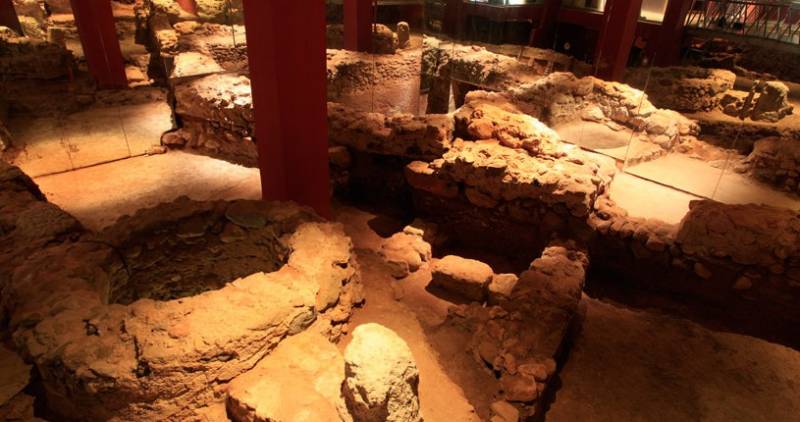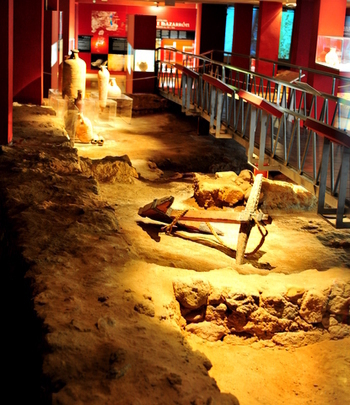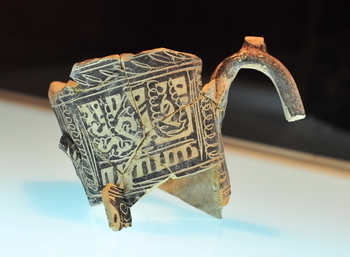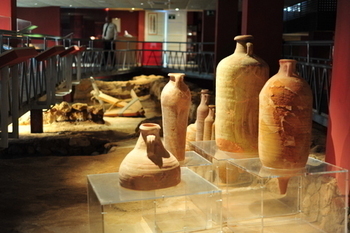Mazarrón Municipal Archaeological Museum The Roman Fish Salting Factory
Museo Arqueológico Municipal de Mazarrón, La Factoría Romana de Salazones
During the 1st century BC, Roman power was at its height and the Empire required vast quantities of goods from across the Mediterranean for consumption elsewhere. Commerce along the Mediterranean coastline provided a wealth of goods and services, each area contributing its own locally produced specialities.
Mazarron had four important products: minerals from its mines, esparto grass (used for a wide range of products including fishing nets, ropes and shoes), salt and fish. The combination of fishing, salt and the warm climate in what is now the Region of Murcia meant that the area was (and still is) perfect for the manufacture of salted fish and fish sauces, and the Roman fish salting factory is an interesting and well preserved example of such an enterprise.

Factories of this nature had existed beforehand but they proliferated in the first century BC, increasing in both size and number along the African coast and southern Spain as fish sauce was an essential component of Roman cookery. The most important sauce of all was "garum", which fetched high prices in Rome, although all grades of fish and the offcuts from the premium quality production were used to make a range of other sauces and other secondary products.
It was a laborious process, which involved maserating the innards of various fish, adding the crumbled flesh of others and then mixing in yet more before the whole was fermented, sieved and bottled.

The natural digestive enzymes of the fish used broke down the solids and salt was added to prevent rotting as the mixture was stored in salting tanks for between twenty days and three months. The sauce was then reduced by the application of heat and filtered to make the purest garum.
The large tanks characteristic of these types of installations can be seen in this museum, and the Mazarrón factory must have been a vast installation, much of which is still buried beneath neighbouring houses. It was not discovered until 1976 during construction works and was declared to be of historical conservation interest in 1995.
The museum comprises 4 sections:
 1. The fish salting factory remains and the process of fish paste production. One interesting little exhibit in this section is a small jar which was uncovered during the excavations and which is believed to have contained offerings to the gods, probably buried to bring good luck when the factory was built.
1. The fish salting factory remains and the process of fish paste production. One interesting little exhibit in this section is a small jar which was uncovered during the excavations and which is believed to have contained offerings to the gods, probably buried to bring good luck when the factory was built.
2. Exhibits and information about Mazarrón from the Paleolithic to the late Roman occupation, covering the trading activities of the Phoenicians (and the two boats which sank in the bay of La Isla). One of these is still in situ, protected with a steel casing, while the second was raised and is now in the ARQUA museum of underwater archaeology in Cartagena (ARQUA).
In Puerto de Mazarrón a visit to the Phoenician boats interpretation centre provides further insights into the wrecks and their background.
3. The late Roman period. Dedicated to the Roman installations discovered in and around Mazarrón, including a burial ground and a house in Calle Era.
4. From the Middle Ages to the present day.

Admission prices and opening times (as of April 2022)102
Address: Calle La Torre / Calle San Ginés, 30860 Puerto de Mazarrón
Telephone: 968 595242
Email: factoriaromana@mazarron.es
Appointments should be requested via www.visitamazarron.com/en/bookings/.
Opening hours
Monday and Tuesday: closed.
Wednesday to Saturday: winter 10.00 to 13.00 and 17.00 to 18.00, summer 10.00 to 13.00 and 18.00 to 21.00
Sunday: 10.00 to 13.00 (all year round)
Entry is free of charge
 Access to the museum is good, with ramps for the disabled throughout. Parking is available in the nearby streets but in summer months this area is extremely busy as it is right next to the marina.
Access to the museum is good, with ramps for the disabled throughout. Parking is available in the nearby streets but in summer months this area is extremely busy as it is right next to the marina.
Some information boards are in English, and there leaflets also provide good information.
Images: Murcia Today and visitamazarron.com (Town Hall site)
For more local visiting information as well as news and events go to the home page of Mazarrón Today.








































